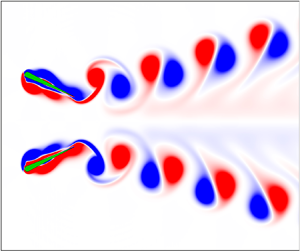Article contents
Flow-mediated organization of two freely flapping swimmers
Published online by Cambridge University Press: 15 February 2021
Abstract

Fish schools and bird flocks, which involve a variety of orderly formations, have fascinated people for a long time. The collective performance of two flapping foils in parallel, which can self-propel in both lateral and longitudinal directions, is numerically studied through two-dimensional simulations in this paper. For the first time it is numerically confirmed that two flapping swimmers can simultaneously converge to equilibrium distances in both lateral and longitudinal directions. Two types of stable formations have been observed and which type occurs depends on the phase difference between two foils. The staggered formation appears in the in-phase scenario, and the side-by-side formation occurs in the anti-phase scenario. Moreover, both types of the stable formations strongly depend on the flapping frequency and amplitude, but are independent of the perturbation of the initial distance between the two foils when the perturbation is small. In addition, considerable velocity enhancement can be achieved by two foils in all of the stable formations, as compared with that of a single foil. Moreover, the velocity of the two-foil system can be couched as a specific scaling law, which is determined by the type of the stable formations. Finally, the mechanism behind the stable formations has been analysed. The results obtained here may shed some light on the understanding of collective behaviour of fish schools and bird flocks.
JFM classification
- Type
- JFM Papers
- Information
- Copyright
- © The Author(s), 2021. Published by Cambridge University Press
References
REFERENCES
- 12
- Cited by





